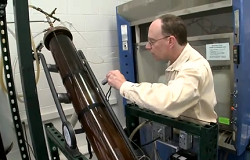 Researchers from the University of Connecticut have come up with a better way to brew up biodiesel.
Researchers from the University of Connecticut have come up with a better way to brew up biodiesel.
This article from PHYSORG.com says Professor Richard Parnas, who you might remember from my story last October also is finding a way to use hemp as a biodiesel feedstock, has developed a patented biodiesel reactor that uses gravity, heat, and natural chemical reactions to make the biodiesel and separate the glycerol in one step:
As the chemical reactions take place inside the giant tube, temperatures reach more than 100 degrees Fahrenheit. The glycerol starts to coagulate in opaque swirls inside the tube. Because the glycerol droplets are heavier than the biodiesel fuel, they gradually sink to the bottom, where they are siphoned off. At the same time, the biodiesel fuel floats to the top of the tube and is pumped into a holding tank, where it undergoes refinement before being mixed with petroleum-based diesel fuel and used in the University’s bus fleet.
“What is unique about our reactor and why we have a patent on it, is that it gives a much better performance for the separation of the glycerol, and we don’t need a special separate step as is used in most other processes,” says Parnas, who also serves as chairman of UConn’s biodiesel consortium research group.
“That motion and those swirls you are seeing when you look at the reactor are the result of both a chemical reaction and phase separation in real time,” Parnas says. “Phase separation is like what happens when you have an oil and vinegar salad dressing … In other biodiesel processes out there, the reactants are very highly mixed and come out of the reactor together.”
While Parnas’ refinery is producing only about 2,000 gallons of biodiesel a year right now, he hopes a $1.8 million grant from the Department of Energy will help them move that production up to commercial quantities soon.

